13-inch Retina MacBook Pro Review (Late 2012)
by Anand Lal Shimpi on November 13, 2012 2:53 AM ESTThermals & Acoustics
When we looked at the 15-inch rMBP we noted that it was a significant improvement in the thermal department compared to the previous, 2011 MacBook Pro. The move to 22nm Ivy Bridge and 28nm Kepler silicon meant a much better power profile than the outgoing model. Apple also changed the way it brings air through the system. The previous MacBook Pro chassis did all air exchanging through vents near the hinge of the machine. The new Retina systems pull in cool air from the sides and exhaust it at the display hinge.
In the 15-inch rMBP the improved cooling combined with more power efficient silicon helped ensure more consistent performance over time. While the 2011 15-inch MacBook Pro would quickly throttle under heavy CPU and GPU load, the 15-inch Retina MBP didn't have to reduce clock speeds as aggressively to keep the system's thermal footprint in check.
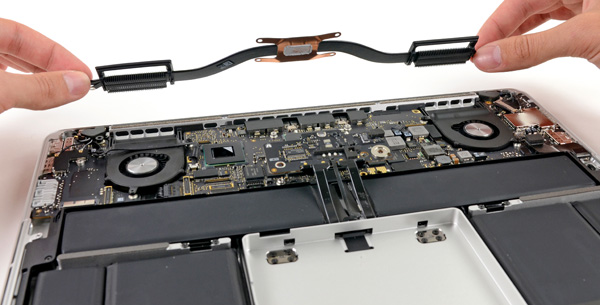
13-inch rMBP cooling solution, courtesy iFixit
With the 13-inch model, the cooling problem is far less of an issue. For starters, Apple only has to remove heat from a single major producer rather than two. There is no discrete GPU in the 13-inch rMBP, so the cooling workload is immediately reduced. Secondly, the 13-inch rMBP is only available with a dual-core 35W Ivy Bridge processor, and not the quad-core 45W parts used in the 15-inch model. With a cooler running CPU and no dGPU, the 13-inch rMBP has a much easier job of staying cool compared to the 15.
To confirm there was no obvious CPU throttling I ran two tests. The first was continuous runs of Cinebench 11.5's multithreaded render benchmark. Prolonged multithreaded FP workloads have always been a great way to drive temperatures up. We didn't see any throttling during this test on the 15-inch rMBP, and it's no surprise that we see no different here with the 13-inch model:
Next up, I ran the same type of test but using Half Life 2 instead. Here I picked settings that provided a good balance of CPU and GPU workload and ran back to back timedemos while monitoring performance:
As expected, there's no obvious drop in performance over time.
Apple also paid attention to acoustics with this generation. Like the 15-inch model, the 13-inch rMBP uses two fans to remove heat from a single heatpipe that runs across the CPU. The fan blades are asymmetrically spaced on each fan to produce a sound that's more varied across the frequency spectrum, rather than concentrated at specific frequencies. The idea is to create the illusion of quiet fans without negatively impacting cooling ability.
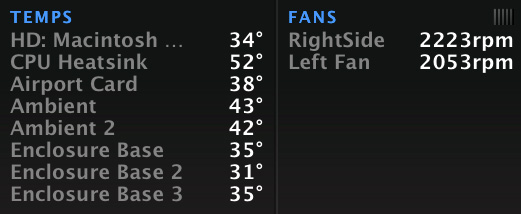
Even more so than in the 15-inch rMBP, Apple's fans in the 13-inch rMBP rarely spin above 2200 RPM. During both the Cinebench and Half Life 2 tests, fan speed remained around 2100 RPM. At these speeds, fan noise is effectively non-existent. In fact, during all of my testing of the 13-inch rMBP there were only a couple of times when I actually heard the fans spin significantly faster than that. Although I would like to see faster silicon and dGPU-level graphics performance in the 13, the obvious benefit of not having four cores and discrete graphics is a very quiet system.
Thermal performance goes hand in hand with acoustics of course. During the Half Life 2 marathon run I kept tabs on CPU and chassis temperature. The results are below:
| Thermal Comparison | ||||
| 13-inch rMBP | 15-inch rMBP | |||
| Max CPU Temp | 52C | 63C | ||
| Max GPU Temp | - | 72C | ||
| Max Surface Temperature (Top) | 48.1C | 49.8C | ||
| Max Surface Temperature (Bottom) | 41.6C | 41.8C | ||
Unfortunately I don't have a 2011 13-inch MacBook Pro to compare to, but the 13-inch rMBP is clearly cooler running than the 15. In terms of user experience, I felt the 13-inch rMBP get warm but never too hot to use on my lap.


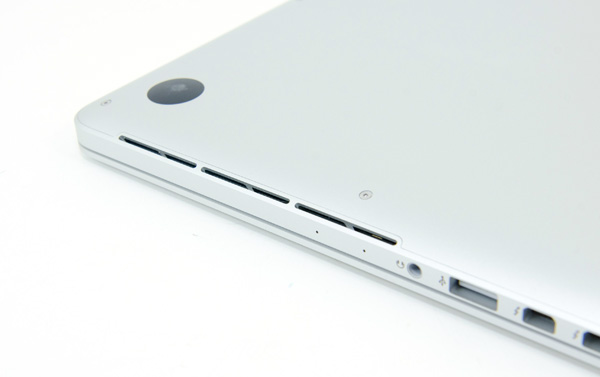
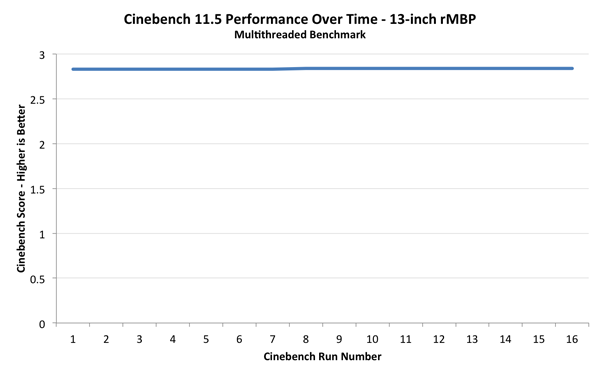
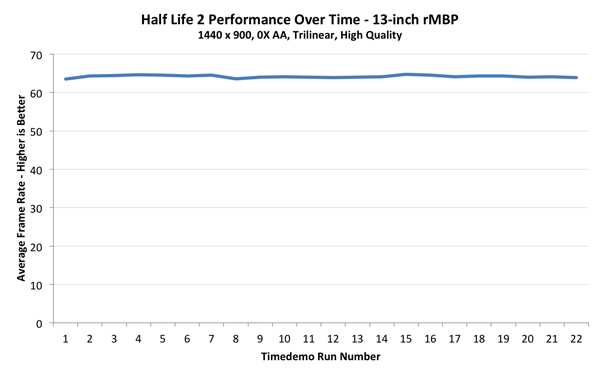








79 Comments
View All Comments
James5mith - Tuesday, November 13, 2012 - link
One of the biggest advances the Windows OS made was moving from a strictly CPU driven windows management interface, to a GPU accelerated one. (Vista, Win7, Win8)It stopped things like the classic "trail of artifact windows" you could do when your old WindowsXP and earlier machines were bogged down. Since the desktop was drawn by the CPU, it wouldn't refresh properly until some CPU cycles were freed up.
Seems Apple did not learn from the past, and is now doomed to repeat it.
Ryan Smith - Tuesday, November 13, 2012 - link
Actually Apple introduced GPU accelerated window composition with Quartz Extreme nearly 10 years ago, a few years ahead of Microsoft.However there are several layers to GPU acceleration. The earliest solutions could do window composition on the GPU, but the contents of the windows themselves were still generated by the CPU. Since then both MS and Apple have been moving more and more of the workload on to the GPU as it makes sense to do so. But no one is 100% offloaded, so the CPU still plays a part and consequently can still be a bottleneck.
michal1980 - Tuesday, November 13, 2012 - link
The bias is strongsolipsism - Saturday, November 17, 2012 - link
Yes, the bias is strong... in you.<ul><li><a href="http://www.anandtech.com/tag/windows-8>http://w...
cjs150 - Tuesday, November 13, 2012 - link
But not yet. One maybe two generations to go before perfect.1. One obvious use of this will be to watch movies on go (especially on long business trips) but once again Apple ignores 1080p resolution (if there someone at Apple who hates this resolution, because they try and ignore it in every device they produce)
2. Card reader is flaky - is it because of chassis flex or just a bad reader?
3. storage needs to be bigger, I gues next generation will be 256gb.
4. A bit extra horse power obviously needed, but probably not a lot.
The real question though is as tablets get better, is there any point in the 13" Mac?
xTRICKYxx - Tuesday, November 13, 2012 - link
What software do you use to test the framerates of the browser?Jorange - Tuesday, November 13, 2012 - link
$1700 and laggy UI. Come on Apple fans admit that you buy their products for the image, and for fear of being seen as gauche in the eyes of your vapid clique. The best Apple zealots are those whom purchase the things on credit, look how wealthy I am, whilst paying off the monthly installments:)boblozano - Tuesday, November 13, 2012 - link
This is the first review that I've read that captures the essence of this machine -- it is a machine of excellent balance, and in that balance lies it's real reason for being.Came from a mid-2011 mbair (1.8 i7, 256gb), and before that a mid-2009 mbp 15. Workload is a mix of writing, photo editing (lr, ps, etc.), and some video creation. Lots of travel. Went to the mbair after good friends with a heavy dev emphasis swore it was excellent. It was/is.
Considered the 15 rMBP since the price is effectively the same, and there is obviously more of just about everything. But size for travel and general mobility was a significant concern (the air allowed me to switch from a full-size backpack to a much smaller messenger bag).
The reason why I've settled on 13 as just about perfect for my present usage is simple: with the increasing number of full-screen apps, 13" is just about perfect for writing in a full screen, while 15 just feels overwrought. Even better, with retina the photo and video editing remains very usable.
With that as a background, the 13" rMBP was a real step up in everything that I liked about the air, with hardly any compromise (small bit of weight). Ended up with the 2.9 I7, 512gb. Everything I do is faster, better (though definitely not cheaper), and that screen just makes you smile when opening it up to work. It is good enough that I'm even going back to using the device open on a stand (trying the new twelve south height-adjustable stand) when docked.
Sure it would be nice to have 4 cores and a discrete gpu (particularly for rendering), but as of now there's no doubt it would have compromised mobility and/or battery life. About the only indisputable criticism is one of value, but such is life.
Undoubtedly (and always) there'll be something much better down the road, maybe even only a year from now. Good. But as of today, this is the best computing device I've ever used on a daily basis.
caleblloyd - Tuesday, November 13, 2012 - link
Anand - the Primary Storage for the 13in MBA that you have listed on the table on the first page should be 128GB.repoman27 - Tuesday, November 13, 2012 - link
"In reality USB 3.0 is good for about 400 - 500MB/s (3.2Gbps - 4.0Gbps)..."The actual reality is that USB 3.0 provides a physical layer gross bit rate of 5 Gbit/s, and a physical layer net bit rate of 4 Gbit/s due to 8b/10b encoding. The net bit rate delivered to the application layer is unlikely to ever exceed 80% of that, or 400 MB/s, in the real world. Even using UASP, which clearly looks to be the case in these tests, I've never seen peak SuperSpeed USB transfer rates much in excess of 350 MB/s. USB 3.0 is good for 300 - 350 MB/s with the hardware shipping at this point, although we may see the upper bound approach 400 MB/s in the future.
"This is Intel's most capable Thunderbolt SKU as it takes four PCIe 2.0 lanes combined with DisplayPort and muxes them into four Thunderbolt channels (2 up/2 down) with two DP outputs."
This sentence has some problems as well. The DSL3510L has connections on the back end for 4 PCIe 2.0 lanes, 2 DisplayPort 1.1a sources and 1 DisplayPort 1.1a sink. On the front side it has four 10 Gbit/s, full-duplex Thunderbolt channels, 2 per port (i.e. 2 up/2 down per port or 4 up/4 down per controller). Each port can also operate in legacy DisplayPort signaling mode when a DisplayPort device is connected directly.
On another note, it's frustrating that Apple failed again at the SDXC card reader, and it appears to be a mechanical issue once again. iFixit's teardown photos seem to have omitted it, but if Apple used the same controller as in the 15-inch MBPR, then it's a Broadcom controller that supports SD 3.0 features such as SDXC and UHS-I paired with a PCIe 1.1 x1 back end. This should make it far more capable than a USB 2.0 based solution, but no, instead they made it useless because half the time it doesn't read a card at all when inserted.